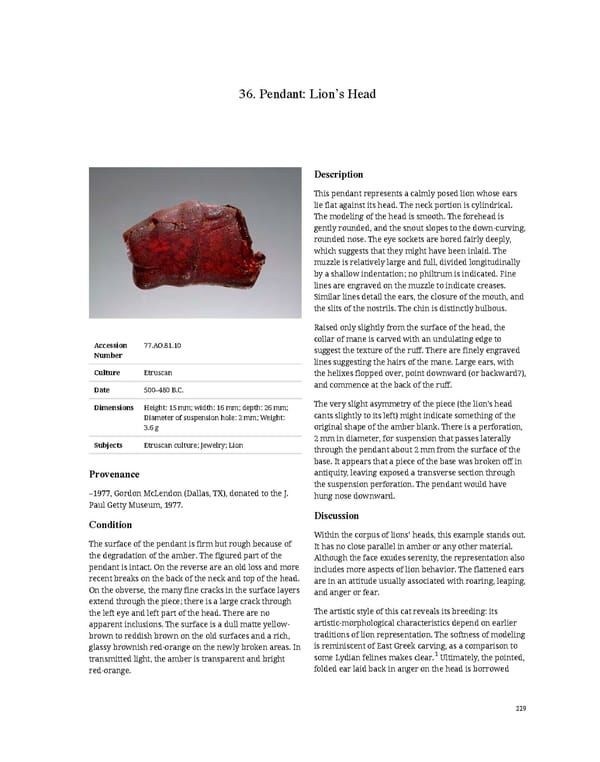36. Pendant: Lion’s Head Description This pendant represents a calmly posed lion whose ears lie flat against its head. The neck portion is cylindrical. The modeling of the head is smooth. The forehead is gently rounded, and the snout slopes to the down-curving, rounded nose. The eye sockets are bored fairly deeply, which suggests that they might have been inlaid. The muzzle is relatively large and full, divided longitudinally by a shallow indentation; no philtrum is indicated. Fine lines are engraved on the muzzle to indicate creases. Similar lines detail the ears, the closure of the mouth, and the slits of the nostrils. The chin is distinctly bulbous. Raised only slightly from the surface of the head, the Accession 77.AO.81.10 collar of mane is carved with an undulating edge to Number suggest the texture of the ruff. There are finely engraved lines suggesting the hairs of the mane. Large ears, with Culture Etruscan the helixes flopped over, point downward (or backward?), Date 500–480 B.C. and commence at the back of the ruff. Dimensions Height: 15 mm; width: 16 mm; depth: 26 mm; The very slight asymmetry of the piece (the lion’s head Diameter of suspension hole: 2 mm; Weight: cants slightly to its left) might indicate something of the 3.6 g original shape of the amber blank. There is a perforation, Subjects Etruscan culture; Jewelry; Lion 2 mm in diameter, for suspension that passes laterally through the pendant about 2 mm from the surface of the base. It appears that a piece of the base was broken off in Provenance antiquity, leaving exposed a transverse section through the suspension perforation. The pendant would have –1977, Gordon McLendon (Dallas, TX), donated to the J. hung nose downward. Paul Getty Museum, 1977. Discussion Condition Within the corpus of lions’ heads, this example stands out. The surface of the pendant is firm but rough because of It has no close parallel in amber or any other material. the degradation of the amber. The figured part of the Although the face exudes serenity, the representation also pendant is intact. On the reverse are an old loss and more includes more aspects of lion behavior. The flattened ears recent breaks on the back of the neck and top of the head. are in an attitude usually associated with roaring, leaping, On the obverse, the many fine cracks in the surface layers and anger or fear. extend through the piece; there is a large crack through the left eye and left part of the head. There are no The artistic style of this cat reveals its breeding: its apparent inclusions. The surface is a dull matte yellow- artistic-morphological characteristics depend on earlier brown to reddish brown on the old surfaces and a rich, traditions of lion representation. The softness of modeling glassy brownish red-orange on the newly broken areas. In is reminiscent of East Greek carving, as a comparison to transmitted light, the amber is transparent and bright some Lydian felines makes clear.1 Ultimately, the pointed, red-orange. folded ear laid back in anger on the head is borrowed 229
 Ancient Carved Ambers in the J. Paul Getty Museum Page 238 Page 240
Ancient Carved Ambers in the J. Paul Getty Museum Page 238 Page 240